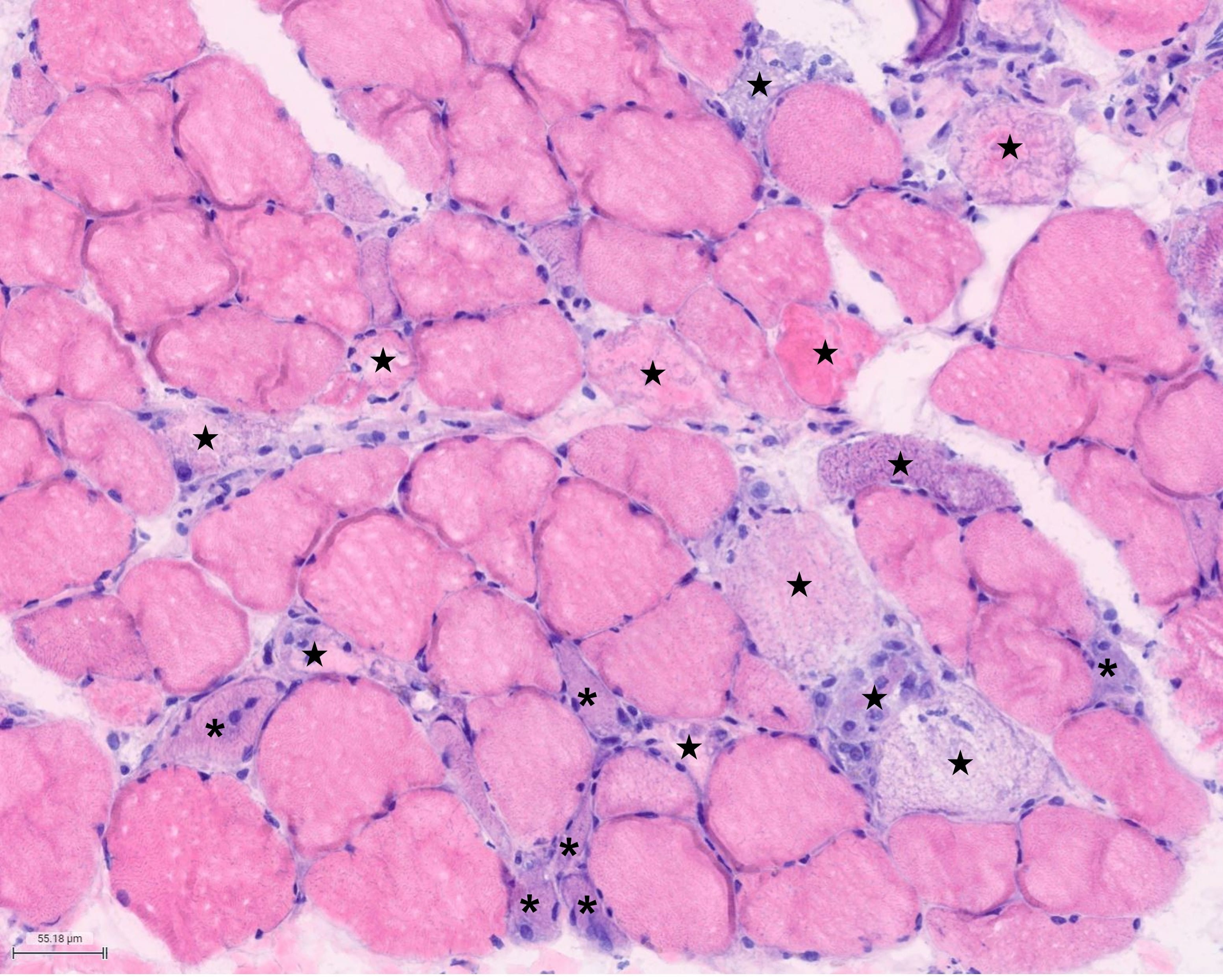Back
Poster Session E - Tuesday Afternoon
E0221 - Dysphagia in Statin-Induced Necrotizing Myopathy: An Uncommon Cause of Dysphagia in Adults
Tuesday, October 25, 2022
3:00 PM – 5:00 PM ET
Location: Crown Ballroom
- MC
Michael Chang, DO
Riverside University Health System
Moreno Valley, CA
Presenting Author(s)
Bhavik Magan, DO1, Michael Chang, DO1, Mari Perez-Rosendahl, MD2, Pejman Solaimani, MD1
1Riverside University Health System, Moreno Valley, CA; 2University of California, Irvine, Irvine, CA
Introduction: Dysphagia due to statin induced myopathy is a rare condition. Statin generally is well tolerated and commonly used to reduce cardiovascular risk. However, myositis, a common complication of statin therapy, can cause disruption in the mechanism of muscles participating in swallowing. Here, we present a rare case of statin induced rhabdomyolysis and myositis causing dysphagia.
Case Description/Methods: A 58-year-old male with metabolic syndrome on statin therapy, was admitted for progressive solid food dysphagia, weakness, and myalgia. Initial vital signs were within normal limits. Physical exam was significant for profound weakness in all extremities. Initial labs were significant for an elevated creatine kinase (CK) of 19,387 U/L suggestive of rhabdomyolysis. CK continued to remain elevated despite aggressive fluid resuscitation. Statin therapy was subsequently held. Additional work up included a muscle biopsy which demonstrated severe necrotizing myopathy. Given the muscle biopsy findings in setting of statin use, 3-Hydroxy-3-Methylglutaryl-Coenzyme A Reductase (HMGCR) IgG antibodies were checked and found to be significantly elevated at above 550 CU (normal less than 20 CU). Patient was then diagnosed with Anti-HMG-CoA Reductase Positive Immune Mediated Necrotizing Myopathy (anti-HMGCR positive IMNM). Patient was then started on immunosuppressive therapy. However, patient’s dysphagia continued to worsen. Given ongoing dysphagia and inability to fulfill all nutritional needs, patient underwent percutaneous endoscopic gastrostomy tube placement. Patient’s condition stabilized after treatment with immunosuppressive therapy.
Discussion: IMNM is a type of auto-immune myopathy that is debilitating due to characteristics of severe muscle weakness and possible muscle necrosis. Biopsy of patients with necrotizing myositis will show myofiber necrosis. The distinguishing feature of HMG-CoA reductase IMNM is the presence of statin therapy. The duration of statin therapy does not appear to affect the development of IMNM. Prior studies have shown that about 6 percent of patients with biopsy proven IMNM also found to have positive anti-HMGCR antibodies. Of those patients with positive antibodies on muscle biopsy, 80 percent had history of statin therapy. Physicians should recognize signs of anti-HMGCR IMNM, such as progressive dysphagia early on in disease process, so the appropriate treatment can be initiated to prevent significant morbidity.

Disclosures:
Bhavik Magan, DO1, Michael Chang, DO1, Mari Perez-Rosendahl, MD2, Pejman Solaimani, MD1. E0221 - Dysphagia in Statin-Induced Necrotizing Myopathy: An Uncommon Cause of Dysphagia in Adults, ACG 2022 Annual Scientific Meeting Abstracts. Charlotte, NC: American College of Gastroenterology.
1Riverside University Health System, Moreno Valley, CA; 2University of California, Irvine, Irvine, CA
Introduction: Dysphagia due to statin induced myopathy is a rare condition. Statin generally is well tolerated and commonly used to reduce cardiovascular risk. However, myositis, a common complication of statin therapy, can cause disruption in the mechanism of muscles participating in swallowing. Here, we present a rare case of statin induced rhabdomyolysis and myositis causing dysphagia.
Case Description/Methods: A 58-year-old male with metabolic syndrome on statin therapy, was admitted for progressive solid food dysphagia, weakness, and myalgia. Initial vital signs were within normal limits. Physical exam was significant for profound weakness in all extremities. Initial labs were significant for an elevated creatine kinase (CK) of 19,387 U/L suggestive of rhabdomyolysis. CK continued to remain elevated despite aggressive fluid resuscitation. Statin therapy was subsequently held. Additional work up included a muscle biopsy which demonstrated severe necrotizing myopathy. Given the muscle biopsy findings in setting of statin use, 3-Hydroxy-3-Methylglutaryl-Coenzyme A Reductase (HMGCR) IgG antibodies were checked and found to be significantly elevated at above 550 CU (normal less than 20 CU). Patient was then diagnosed with Anti-HMG-CoA Reductase Positive Immune Mediated Necrotizing Myopathy (anti-HMGCR positive IMNM). Patient was then started on immunosuppressive therapy. However, patient’s dysphagia continued to worsen. Given ongoing dysphagia and inability to fulfill all nutritional needs, patient underwent percutaneous endoscopic gastrostomy tube placement. Patient’s condition stabilized after treatment with immunosuppressive therapy.
Discussion: IMNM is a type of auto-immune myopathy that is debilitating due to characteristics of severe muscle weakness and possible muscle necrosis. Biopsy of patients with necrotizing myositis will show myofiber necrosis. The distinguishing feature of HMG-CoA reductase IMNM is the presence of statin therapy. The duration of statin therapy does not appear to affect the development of IMNM. Prior studies have shown that about 6 percent of patients with biopsy proven IMNM also found to have positive anti-HMGCR antibodies. Of those patients with positive antibodies on muscle biopsy, 80 percent had history of statin therapy. Physicians should recognize signs of anti-HMGCR IMNM, such as progressive dysphagia early on in disease process, so the appropriate treatment can be initiated to prevent significant morbidity.

Figure: Muscle biopsy showing numerous pale necrotic myofibers (stars) and basophilic regenerating myofibers (asterisks) in varying stages of necrosis and regeneration. Image courtesy of Dr. Mari Perez-Rosendahl MD, University of Califorina, Irvine.
Disclosures:
Bhavik Magan indicated no relevant financial relationships.
Michael Chang indicated no relevant financial relationships.
Mari Perez-Rosendahl indicated no relevant financial relationships.
Pejman Solaimani indicated no relevant financial relationships.
Bhavik Magan, DO1, Michael Chang, DO1, Mari Perez-Rosendahl, MD2, Pejman Solaimani, MD1. E0221 - Dysphagia in Statin-Induced Necrotizing Myopathy: An Uncommon Cause of Dysphagia in Adults, ACG 2022 Annual Scientific Meeting Abstracts. Charlotte, NC: American College of Gastroenterology.
